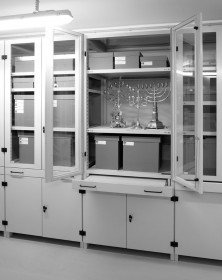Film Historian Claudia Dillmann on the Artur Brauner Film Collection in Our Library
The German film producer and Shoah survivor Artur Brauner has kindly donated to our Museum twenty-one films on the subject of the Shoah and the Nazi era—you’ll find the complete list on our website. Today, the Museum acknowledges our great appreciation of this gift with a special event in the presence of Artur Brauner and his family.
Prior to the event we interviewed film historian Claudia Dillmann about Artur Brauner and the appeal of his film productions, in particular for a Jewish Museum. Ms. Dillmann is Director of the German Film Institute in Frankfurt Main and a renowned expert on Artur Brauner, and also initiated the online resource www.filmportal.de. She talked to us about Brauner’s interest in the victims of Nazi crimes, the balancing acts it has called for, his veneration of Romy Schneider, and the German public’s tastes.
Mirjam Bitter, Blog Editor: Ms. Dillman, in your opinion, how representative is our Artur Brauner Film Collection of Mr. Brauner’s entire production list?
Claudia Dillmann: The films that Artur Brauner has donated to the Jewish Museum are indeed representative since they constitute a pivot of his career—one very dear to his heart—namely an abiding commitment to exposing the Holocaust, not least because forty-nine of his own relatives also lost their lives then. He sees these films as his personal “legacy,” one he has been forging since the start of his career. They are dedicated to victims of the Nazi regime and constitute a cycle that in his view is still not complete. In them, he has continually explored new facets of persecution under the Nazi terror and of the traumata he lived through himself. → continue reading


